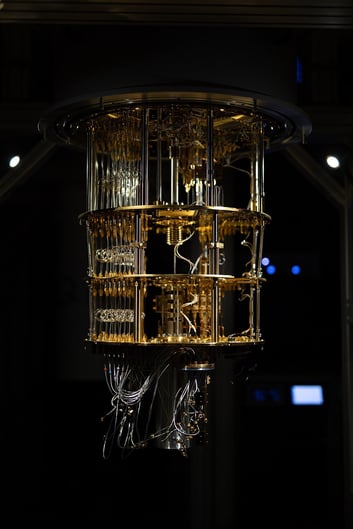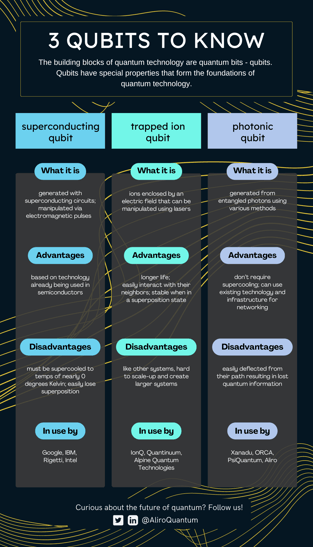
The building blocks of quantum technology are quantum bits - qubits. These are the smallest units of information and are the quantum version of the classical binary bit. For more, check out our in-depth technical article on qubits, specifically photonic qubits, with some real-world examples here.
We wanted to re-visit this topic and look at the various kinds of qubits and the practicality of some types of qubits that are being used and experimented with.
All qubits have special properties that are integral to quantum technology. The properties of qubits that quantum technology takes advantage of:
- Superposition: the ability to exist in multiple states at once. For a qubit, that means it is simultaneously equal to 1 AND 0 until it’s measured definitively. Only then can we know its state for certain is 1, or 0. This is the one of the properties that makes quantum technology potentially capable of being orders of magnitude faster than classical counterparts, which are limited to discrete states.
- Entanglement: when two qubits are entangled, they remain connected even when separated by incredible distances. For example, that could mean entangled partner qubits share the exact same state no matter the distance. This is the property that makes secure communications and highly precise sensors possible.
Qubits are created when particles - ions, photons, electrons, etc. - are given these special properties. But not all qubits are created equal: how the qubits are created determines other key traits of the qubit, like its ideal operating environment. Currently there is no standardized qubit, but there are a few types that have risen in popularity.
Here we’ll be discussing only three types of qubits: superconducting qubits, trapped ion qubits, and photonic qubits. Keep in mind that there are other types of qubits, each with different advantages and disadvantages.
Superconducting Qubits
Superconducting qubits are created using superconducting circuits inside a quantum computer to create entanglement. These qubits are manipulated using electromagnetic pulses to control the magnetic flux, electric charge, or phase difference across specific areas of the superconducting circuit. These qubits are used by Google’s Sycamore processor. This is the processor Google used to show quantum supremacy in 2019. In 2021, IBM used superconducting qubits to build its record breaking 127-qubit Eagle quantum computer.
An advantage of using superconducting qubits is that they are based on technology already being used in semiconductors and operate very fast in experimental quantum computers. However, superconductors must be kept at temperatures of nearly 0 degrees Kelvin in order to operate. This type of qubit also loses its superposition easily compared to other qubit types.
 Working IQM Quantum Computer installed in Espoo, Finland.
Working IQM Quantum Computer installed in Espoo, Finland.
Attribution: Ragsxl, CC BY-SA 4.0 <https://creativecommons.org/licenses/by-sa/4.0>, via Wikimedia Commons
Trapped Ion Qubits
Trapped ion qubits are created when an ion is enclosed by an electric field and are manipulated with lasers. This type of qubit has been preferred by academia for a while, and in 1995 trapped ion qubits formed the foundation of the first basic quantum circuit.
This type of qubit is being used by IonQ, Quantinuum, Alpine Quantum Technologies, and others to develop quantum computers. The advantages to utilizing trapped ion qubits are that they have a longer life and can easily interact with their neighbors. They’re also very stable when in a superposition state. Like other platforms, trapped ion qubits have been limited in scale thus far, though it may be possible to build larger systems by connecting multiple traps in a cluster.
Photonic Qubits
Photonic qubits are made up of entangled photons. There are a few ways of generating photons to be used as qubits. This type of qubit is used to create connections between processors, making it possible to create and scale smaller processors to increase performance.
The big names that are leveraging this type of qubit in computing are Xanadu, ORCA, and PsiQuantum. Photonic qubits are also used by quantum networking by companies like Aliro. Like other qubits, photonic qubits can represent, encrypt, transmit, and detect superposition states. The advantages to using photonic qubits are they don’t require supercooling and can travel over existing fiber-optic cable, making them an ideal option in building a quantum internet in the future. However, photonic qubits are easily deflected or absorbed on the way to their destination. When that happens, the quantum information is lost.
You can deep dive into more detail about photonic qubits in this previous blog post.
The unique properties of qubits may have a huge impact on computing in areas as diverse as pharmaceuticals, materials science, and logistics. These same properties could have potentially game-changing impact when used to create quantum networks. Networked sensors for more power / precision, unhackable communication networks, and even connecting existing quantum computers to increase computing power without requiring much larger quantum processors. For some real-world examples of how qubits function, check out our blog.
Want the latest in quantum technology developments delivered straight to your inbox once a month?
Sign up for our newsletter, where we share the biggest news about quantum networks and related technologies, alongside interesting and informative content.
Click the image below to view a larger version.

